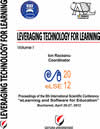FROM LINEAR TO NONLINEAR PHENOMENA THROUGH COMPUTER SIMULATION
FROM LINEAR TO NONLINEAR PHENOMENA THROUGH COMPUTER SIMULATION
Author(s): Nicolae Micescu, Mircea Victor Rusu, Emil Ştefan BarnaSubject(s): Education
Published by: Carol I National Defence University Publishing House
Keywords: Dynamical systems; nonlinearity; teaching methodology in physics
Summary/Abstract: In order to better grasp the natural phenomena, we must recognize the roll of nonlinear effects as a major improvement for describing reality. Accordingly, we have as a purpose the development of a gradual introduction of the so-called “nonlinear dynamic systems” as a turning point for better understanding the nature. The true value of the computer approach is revealed for solving, modelling and/or simulating nonlinear phenomena. In order to do that, we are preparing a series of lectures and applications for different phenomena that are simple enough to understand but difficult to compute, in a gradual way. We analyze a series of phenomena, and develop algorithms for computing or simulating them. The project also includes instructions for teaching as well as examples and proposes a thematic for further developments. It is not intended to fully develop all the phenomena, but to open a road that should be followed for all types of problems of main interest. Among these we can mention the following: oscillators of different kinds, linear, coupled, collection of oscillators, non-linear oscillators, damping and non-autonomous oscillators, exemplified by mechanic, electric or optical systems. We will also develop simulations for Verhulst dynamics, logistic developments, pray-predator systems and not only. The whole project involve a series of lectures developed and based mainly on the Romanian curricula and on the textbooks that exist in the bookshops [9], [10], [21].
Journal: Conference proceedings of »eLearning and Software for Education« (eLSE)
- Issue Year: 8/2012
- Issue No: 01
- Page Range: 526-531
- Page Count: 6
- Language: English

